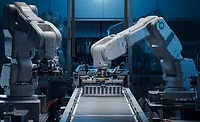Automate, Digitize, and Thrive in the Supply Chain
As the labor market tightens with changing demographics, companies will need to leverage technology and digitize their supply chains.

Image courtesy of Scharfsinn86 / iStock / Getty Images Plus
The world has never experienced a labor shortage quite like the one we are experiencing. According to the Bureau of Labor Statistics, employment growth will average .3 over the next decade; however, labor participation will drop from 62.2% to 60.4%. In essence, we have entered a secular labor shortage. Similarly, according to the German Chamber of Commerce and Industry, half of German companies are struggling to fill vacancies due to labor shortages. Thus, the only companies that will thrive in the next decade will leverage technology and digitize the supply chain.
The use of technology and automation will be of paramount importance to not just supplement the labor force, but also to meet ever increasing customer requirements and provide visibility across the end-to-end supply chain. Companies must be faster, focused, and perform with lights-out manufacturing and logistics to succeed. Thus, a modern ERP system will be an assumption, not a differentiator. In addition, companies must pursue advanced technologies such as business intelligence and predictive analytics to forecast the future and determine where to focus, artificial intelligence, and IoT solutions to support items such as predictive maintenance, and digital twins to optimize process and product performance.
Pertinent Examples
An electrical power solutions manufacturer struggled with an ERP system upgrade, and it impacted every aspect of the business, requiring additional resources to support customer requirements. A base ERP system is no longer acceptable. Instead, a modern ERP system that supports customer expectations such as configure-to-order (CTO), customer relationship management (CRM), and customer-related functionality — including customer portals, order fulfillment visibility and backlog management — is essential.
Since the ERP team didn’t have the time required to fully prepare, the executives quickly supplemented with additional consulting and temporary resources, developed interim solutions for tracking backlog, and ordered ahead to support the transition. Even with one of the best management teams in the industry, until modern ERP functionality was available, they had to implement several stop-gap measures to avoid significant customer impact.
An industrial manufacturer struggled to forecast revenue accurately one month ahead, causing frustration with their board of directors. An assessment of their business processes and use of technology showed that their sales and order entry systems did not talk with their production and inventory control systems. Although Sales could estimate revenue, Operations had no idea which products would be required to support that revenue until Engineering completed design. Thus, although performing above expectations, the two rarely met.
To turn this situation around, we had to build a bridge between the two systems with a data model. However, that alone wouldn’t resolve the issue, as the product details were not known soon enough to ensure seamless delivery and revenue predictability. Thus, in addition, the team created a digital-twin-type capability to predict the product grouping and model information with a SIOP (sales inventory operations planning) process so that materials could be purchased and capacity planned. Once this information was built into automated dashboards, Production was able to transition from reactive to proactive, thereby creating predictability in shipping plans and taking it a step further with proactive margin enhancement strategies.
An aerospace manufacturer continually struggled with on-time delivery, and customers were losing patience. The issue was a bottlenecked area of the manufacturing process that simply could not keep up. They could not find enough high-skilled resources to run the machinery on second and third shifts, and overtime was maxed out. The team pursued an alternate strategy to employ a technological solution to run lights out around the clock.
They purchased a robot and focused their most advanced resources on modifying the robot to work in their manufacturing environment. With the upgraded robot, their high-skilled resources refocused attention on setting up the machinery during day shift, which allowed the robot to perform the repetitive tasks on second and third shift. Order delivery performance improved rapidly, and customer complaints disappeared as the bottleneck was removed. Later, they focused on upgrading their distribution processes with lights-out capabilities as well to further differentiate performance.
Forward-thinking companies will pursue smart technology upgrades while their competition focuses on containing cost. The companies that figure out how to do more with less and digitize their supply chain will thrive while the rest struggle. Resources will no longer be plentiful, and so pivoting with technology will be the only route to executing successfully while meeting ever increasing customer expectations.
For more information, contact the author at landerson@lma-consultinggroup.com or visit www.lma-consultinggroup.com.
Looking for a reprint of this article?
From high-res PDFs to custom plaques, order your copy today!








